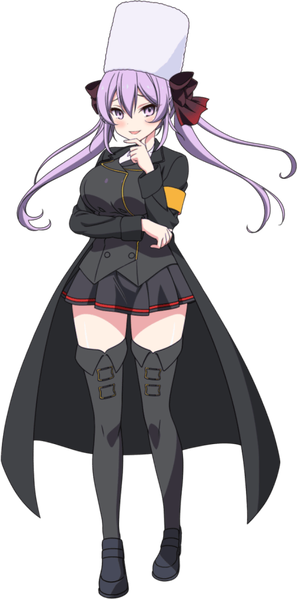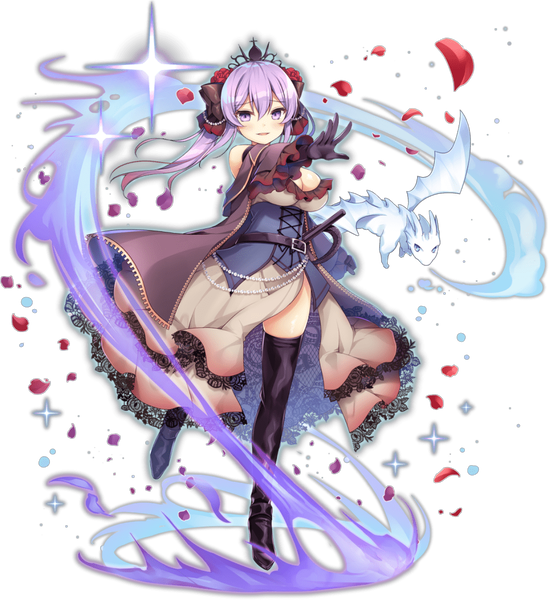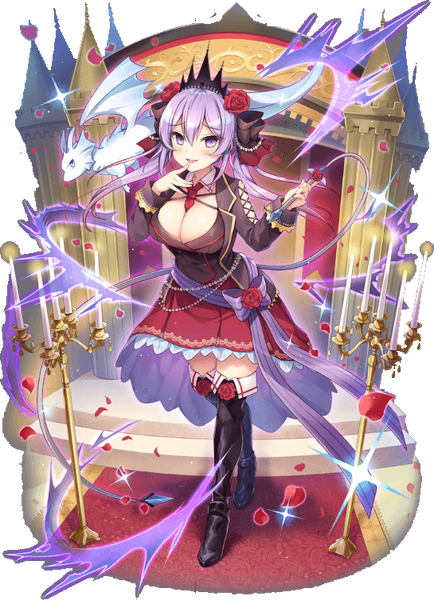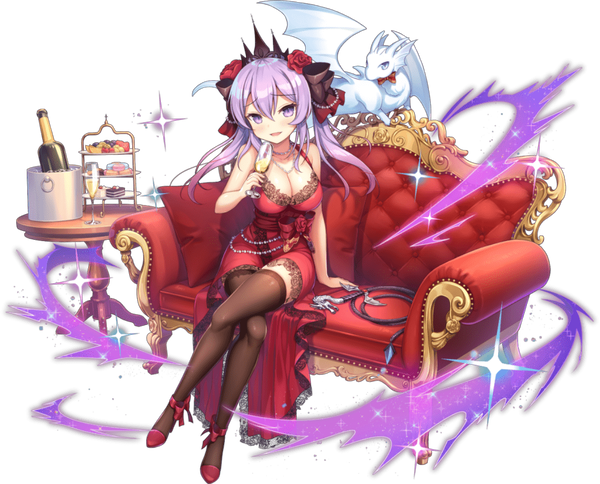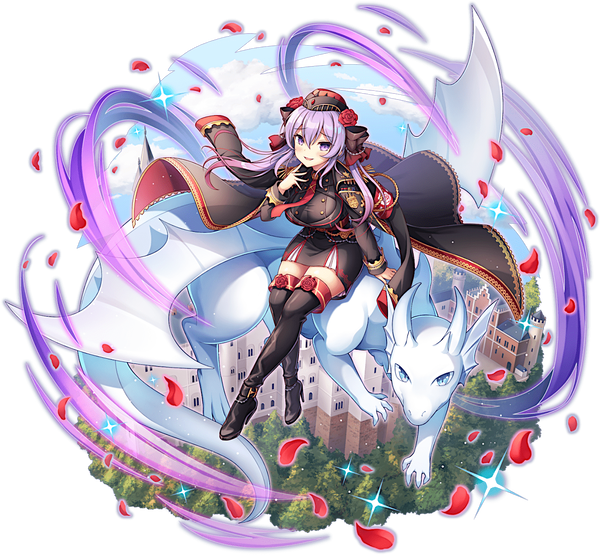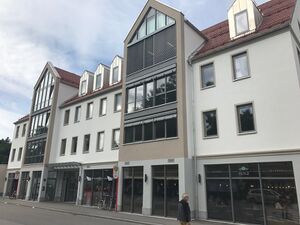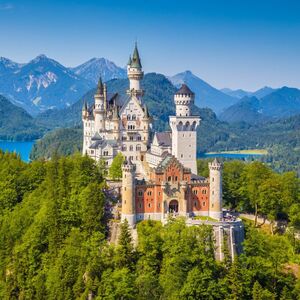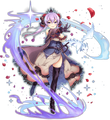Fussen
| Fussen | |||||
|---|---|---|---|---|---|
| Japanese Name | フュッセン | ||||
| Weapon | |||||
| Race | Human | ||||
| Nationality | |||||
| Birthday | August 25 | ||||
| Constellation | Virgo | ||||
| Talents | Able to dominate lesser monsters | ||||
| Likes | Works of art, Pretty things | ||||
| Dislikes | Interacting with the common man, Obligations of the general public | ||||
| Strengths | Has a keen eye for aesthetics | ||||
| Weaknesses | Uninterested in engaging with society | ||||
| Hobbies | Collecting art | ||||
You wish to learn about me? I am not even remotely interested in you. I'm a descendant from a royal family that has ruled over Eisengrad for ages. Well, that's all you need to know.
Layers
| Icon | Title | Release Date | Where to Obtain |
|---|---|---|---|
| [Selfish Royal] Fussen | 2021 August 30 (EN) | Premium Gacha | |
| [With a White Dragon in Tow] Fussen | 2021 December 22 (EN) | [Relaxing Rebirth in Paradise] Limited Gacha | |
| [Spoiled Aristocrat's Incognito Vacation] Fussen | 2023 February 28 | [Scarlet Tears and the Ore of Blessing] Pick Up Gacha, Premium Gacha | |
| [Kneel Before the Queen] Fussen | 2021 August 30 (EN) | Tower Ticket Gacha, Panel Mission | |
| [A Graceful Toast] Fussen | 2021 September 16 | 1st Anniversary Limited Gacha 1 | |
| [On Cinderella's Back] Fussen | 2023 October 24 | [Arrogant Military Princess and the Purgatory Drunken Fist] Limited Gacha |
Owned Skills
Trivia
- Fussen's birthday is shared with Ludwig II (the Mad King) of Bavaria, who was born in 1845.
- Fussen's personality and character is also a homage to King Ludwig II, sharing similar preferences and a defiant personality - she continued to be wasteful on lavish expenses after the abolition of the Eisengrad royalty and founding of the Eisengrad Republic, though like King Ludwig II, the big projects actually provided a lot of jobs for Eisengrad, like King Ludwig II with Bavaria.
- Fussen possesses the Ancient Great Blood in her lineage, providing her very high resistance to cold, described as "no different to an afternoon tea party". Different from Volklingen's Ancient Great Blood however, is her ability to overpower monsters forcefully under her control via blood manipulation in their bodies.
- The background of [Kneel Before the Queen] is the Neuschwanstein Castle. Her hair accessories are also a reference to the castle's spire design.
- Cinderella is the name of Fussen's "pet" dragon (servant under contract). The painting of Saint George and the Dragon can be found inside Neuschwanstein Castle. Neuschwanstein castle was commissioned by King Ludwig II, and the castle is also one of the inspirations of Cinderella Castle in Disneyland.
- Fussen's relationship with Karlsruhe is hostile, due to her suspicions of Karlsruhe behind the abolition of the Eisengrad royalty, as well as Karlsruhe's personal disdain of the corruption prior to the formation of the Eisengrad Republic. Both Karlsruhe and Fussen are often sarcastic towards each other.
Counterpart
Bahnhof Füssen is the station in the town of Füssen, Bavaria, Germany. It has two platform tracks and is classified by Deutsche Bahn as a category 6 station. It is served by about 20 trains of Deutsche Bahn daily and used by approximately 2,700 passengers daily. The station is the terminus of the Biessenhofen–Füssen railway, also known as the König-Ludwig-Bahn ("King Ludwig Railway").
Apart from Füssen station, the town once had a station called Hopfensee. In addition, Ulrichsbrücke-Füssen station on the Ausserfern Railway is named after the town; it is about five kilometres to the southwest in Austria.
On 14 March 1888, Prince Regent Luitpold granted the concession for the construction of the Oberdorf–Füssen line to the Lokalbahn AG (LAG) company. The railway and Füssen station were put into operation on 1 December 1888. The station was connected by a wide road to the centre of Füssen. A two-story house was built next to the station for railway employees. The station building was built to the south of the railway tracks in a style then typical of the LAG and has similarities to the station buildings in Bad Heilbrunn and Oberau. The ground floor was built of freestone, the first floor was constructed with trusses, with the compartments filled with exposed brick. The attic was built with a wooden structure.
During the adoption of a new transport plan for central Füssen 2006, it was decided to demolish the old station building and replace it with a new building. A local referendum to reverse the decision to demolish the building was unsuccessful. The old station building was demolished in 2015, the new building finished in 2016.
The station is at the end of the line and has two platform tracks on an island platform, which are fully accessible behind the buffer stops. The station, however, has no electronic destination displays. Two additional sidings exist, only one of which is still connected. Wikipedia
Neuschwanstein Castle (Schloss Neuschwanstein/Schloss Neischwanstoa) is a 19th-century historicist palace on a rugged hill above the village of Hohenschwangau near Füssen in southwest Bavaria, Germany. The palace was commissioned by King Ludwig II of Bavaria as a retreat and in honour of Richard Wagner. Ludwig chose to pay for the palace out of his personal fortune and by means of extensive borrowing, rather than Bavarian public funds. Construction began in 1869, but was never fully completed.
The palace can be regarded as typical for nineteenth-century architecture. The shapes of Romanesque (simple geometric figures such as cuboids and semicircular arches), Gothic (upward-pointing lines, slim towers, delicate embellishments) and Byzantine architecture and art (the Throne Hall décor) were mingled in an eclectic fashion and supplemented with 19th-century technical achievements. The Patrona Bavariae and Saint George on the court face of the Palas (main building) are depicted in the local Lüftlmalerei style, a fresco technique typical for Allgäu farmers' houses, while the unimplemented drafts for the Knights' House gallery foreshadow elements of Art Nouveau. Characteristic of Neuschwanstein's design are theatre themes: Christian Jank drew on coulisse drafts from his time as a scenic painter.
The building design was drafted by the stage designer Christian Jank and realized by the architect Eduard Riedel. For technical reasons, the ruined castles could not be integrated into the plan. Initial ideas for the palace drew stylistically on Nuremberg Castle and envisaged a simple building in place of the old Vorderhohenschwangau Castle, but they were rejected and replaced by increasingly extensive drafts, culminating in a bigger palace modelled on the Wartburg. The king insisted on a detailed plan and on personal approval of each and every draft. Ludwig's control went so far that the palace has been regarded as his own creation, rather than that of the architects involved. Whereas contemporary architecture critics derided Neuschwanstein, one of the last big palace building projects of the nineteenth century, as kitsch, Neuschwanstein and Ludwig II's other buildings are now counted among the major works of European historicism. Wikipedia
Map
Gallery
- Pages using Tabber parser tag
- Pages using DynamicPageList3 parser tag
- Weapon Whip
- Human
- Eisengrad
- Virgo
- Element Blow
- Element Light
- Element Water
- Element Fire
- Train Knights
- Germany

